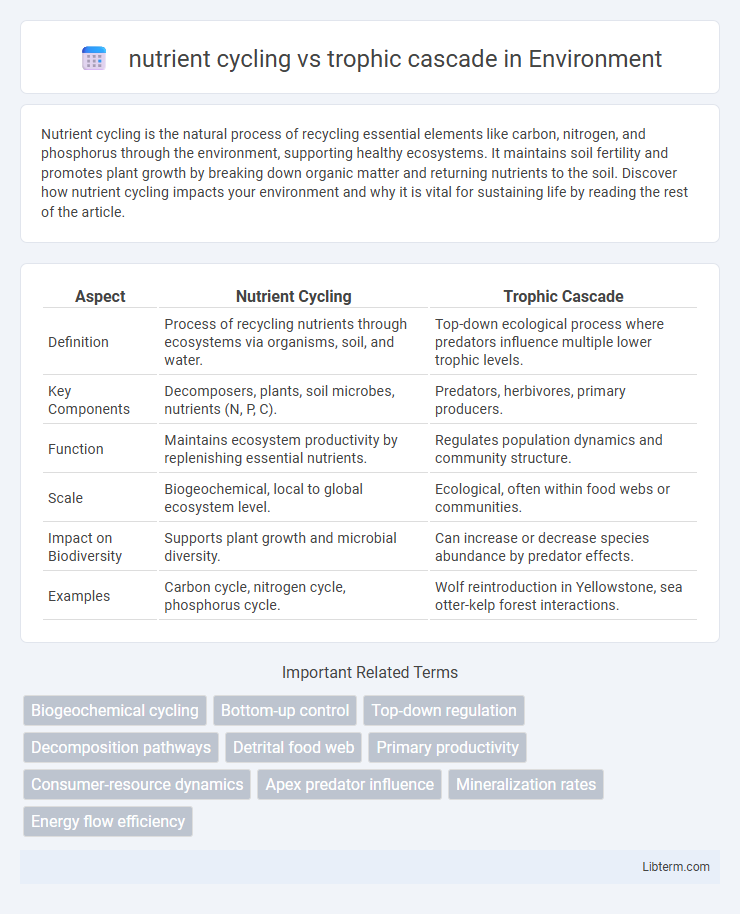Nutrient cycling is the natural process of recycling essential elements like carbon, nitrogen, and phosphorus through the environment, supporting healthy ecosystems. It maintains soil fertility and promotes plant growth by breaking down organic matter and returning nutrients to the soil. Discover how nutrient cycling impacts your environment and why it is vital for sustaining life by reading the rest of the article.
Table of Comparison
| Aspect | Nutrient Cycling | Trophic Cascade |
|---|---|---|
| Definition | Process of recycling nutrients through ecosystems via organisms, soil, and water. | Top-down ecological process where predators influence multiple lower trophic levels. |
| Key Components | Decomposers, plants, soil microbes, nutrients (N, P, C). | Predators, herbivores, primary producers. |
| Function | Maintains ecosystem productivity by replenishing essential nutrients. | Regulates population dynamics and community structure. |
| Scale | Biogeochemical, local to global ecosystem level. | Ecological, often within food webs or communities. |
| Impact on Biodiversity | Supports plant growth and microbial diversity. | Can increase or decrease species abundance by predator effects. |
| Examples | Carbon cycle, nitrogen cycle, phosphorus cycle. | Wolf reintroduction in Yellowstone, sea otter-kelp forest interactions. |
Introduction to Ecosystem Processes
Nutrient cycling involves the continuous movement and exchange of organic and inorganic matter back into the production of living matter, sustaining ecosystem productivity by recycling essential elements like carbon, nitrogen, and phosphorus. Trophic cascades describe the top-down effects predators have on lower trophic levels, influencing species population dynamics and ecosystem structure through indirect interactions. Understanding these processes is crucial for comprehending ecosystem energy flow, species interactions, and nutrient availability that regulate ecosystem functioning.
Defining Nutrient Cycling
Nutrient cycling refers to the continuous movement and exchange of essential elements like carbon, nitrogen, and phosphorus through ecosystems, involving processes such as decomposition, assimilation, and mineralization. This cycle sustains ecosystem productivity by recycling nutrients from organic matter back to the soil and water, making them available for primary producers. Unlike trophic cascades, which describe the indirect effects of predators on lower trophic levels, nutrient cycling emphasizes the biochemical pathways that maintain ecosystem nutrient balance.
What Is a Trophic Cascade?
A trophic cascade is an ecological phenomenon triggered when predators at higher trophic levels indirectly affect populations at lower levels, leading to significant changes in ecosystem structure and nutrient availability. This top-down control can alter primary producer abundance, nutrient cycling rates, and overall biodiversity by regulating herbivore populations and influencing soil and water nutrient dynamics. Understanding trophic cascades is essential for ecosystem management, as they illustrate the critical link between predator-prey interactions and nutrient flow within food webs.
Key Differences Between Nutrient Cycling and Trophic Cascades
Nutrient cycling involves the continuous movement and exchange of organic and inorganic matter back into the production of living matter, primarily focusing on elements like carbon, nitrogen, and phosphorus within ecosystems. Trophic cascades refer to the top-down effects predators have on lower trophic levels, influencing population dynamics and ecosystem structure. The key difference lies in nutrient cycling's emphasis on biogeochemical processes sustaining ecosystem productivity, whereas trophic cascades highlight species interactions and their regulatory impacts on food web dynamics.
Mechanisms Driving Nutrient Cycling
Microbial decomposition and nutrient mineralization drive nutrient cycling by breaking down organic matter into bioavailable forms such as nitrogen, phosphorus, and carbon. Soil organisms and plant roots facilitate nutrient uptake and recycle essential elements within ecosystems, maintaining soil fertility and productivity. Enzymatic activity and abiotic factors like temperature and moisture regulate the rate of nutrient transformations, influencing ecosystem nutrient dynamics.
Predator-Prey Dynamics in Trophic Cascades
Predator-prey dynamics play a crucial role in trophic cascades by regulating population sizes and influencing energy flow across ecosystem levels. Predators control herbivore abundance, which indirectly affects plant biomass and nutrient cycling rates within the ecosystem. This top-down regulation helps maintain ecosystem stability and promotes nutrient redistribution through alterations in species interactions.
Impacts on Biodiversity and Ecosystem Health
Nutrient cycling enhances biodiversity and ecosystem health by recycling essential elements like nitrogen and phosphorus, supporting plant growth and maintaining soil fertility. Trophic cascades restructure food webs by altering predator-prey relationships, which can lead to significant changes in species composition and ecosystem stability. Both processes critically influence ecosystem resilience, with nutrient cycling stabilizing foundational resources and trophic cascades driving species diversity through top-down regulation.
Human Influences on Nutrient Cycling and Trophic Cascades
Human influences on nutrient cycling include agricultural runoff, deforestation, and urbanization, which drastically alter the availability and distribution of essential nutrients like nitrogen and phosphorus in ecosystems. These disruptions can trigger trophic cascades by affecting primary producers and consequently altering the population dynamics of herbivores and predators. Industrial pollutants and climate change further exacerbate these effects by modifying nutrient cycles and destabilizing food webs, leading to reduced biodiversity and ecosystem resilience.
Case Studies: Nutrient Cycling and Trophic Cascades in Action
Case studies demonstrate that nutrient cycling regulates ecosystem productivity by recycling essential elements like nitrogen and phosphorus through soil, plants, and microbes, maintaining nutrient availability and supporting biodiversity. Trophic cascades, illustrated by predator-prey dynamics in Yellowstone National Park, show how apex predators like wolves influence herbivore populations, indirectly enhancing plant growth and nutrient distribution. These interactions reveal the interconnectedness of nutrient flows and species interactions in shaping ecological balance and resilience.
Integrating Both Concepts for Ecosystem Management
Integrating nutrient cycling and trophic cascade concepts enhances ecosystem management by linking energy flow and nutrient dynamics to biodiversity and food web interactions. Understanding how nutrient availability influences trophic levels and how predator-prey relationships regulate nutrient redistribution promotes balanced ecosystem functioning. Effective management strategies leverage this integration to maintain ecosystem resilience, optimize nutrient retention, and control population dynamics across trophic hierarchies.
nutrient cycling Infographic

 libterm.com
libterm.com